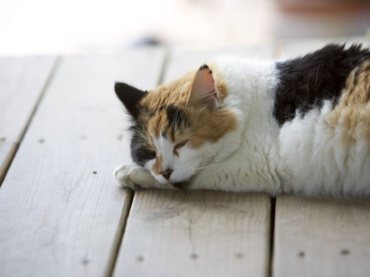Article originally published on The Spruce Pets. Written by Franny Syufy. Refer to the original article here.
You know the drill: the sun is blinding, relentlessly beating down like something out of an old Western movie. If you don’t have air conditioning, you seek out shady spots and sigh in relief from the slightest breeze, otherwise, you huddle inside. If you stay in the sun too long you may become dizzy, have heart palpitations, and increased internal temperature, all signs of impending heat exhaustion.
Consider this: before you ever reach that point, your cat may also be showing signs of heat exhaustion or heat stroke. Although heat stroke is more commonly discussed in dogs, because of people’s propensity to leave them in parked cars, cats can be affected too. Cats can’t always tell you they’re not feeling up to par, but they sure can show you. Early symptoms of heat stroke and the accompanying dehydration are:
- Panting
- Anxiety, possibly demonstrated by pacing
- Increased heartbeat
- Respiratory distress or hyperventilation (Breeds with flat noses, such as Persians, may exhibit this earlier because of compromised airways.)
- Dark red gums
- Lethargy
- Increased internal body temperature Your cat’s internal temperature should be between 100.5 and 101.5 F. A temperature of 104 For more is a definite warning sign.
How to Help Your Cat Avoid Heatstroke
You can help your cat survive extremely hot weather by keeping him indoors in a cool interior room. Rubbing him down with a damp towel will help; so will immersing his feet in a tub of cool water. Wrapping a cold compress under the cat’s neck will also help cool him off. He may fight at first, but most likely will appreciate it once he gets used to the idea. Try wrapping a plastic bag of frozen peas in a towel, and place in his bed for a cool spot to lie. The peas will rearrange themselves to fit his contours and he’ll have a “custom spa” for cooling off.
:max_bytes(150000):strip_icc():format(webp)/drying-the-cat-464899681-5c3fd2d946e0fb000109fdef.jpg)
Provide Fresh Cool Water
The optimum water bowl is an automatic water dispenser. There is a variety of them on the market, but after testing many over the years, I have returned time and again to my favorite, the Drinkwell Platinum Pet Fountain I have three of them in my home – one in the dining room, one in my bedroom and one in my son’s bedroom. As anyone who has ever dipped a toe in a mountain spring knows, fresh, flowing water stays naturally cool.
Lacking an automated fountain, make sure your cat has several bowls of cool water available. It doesn’t hurt to drop an ice cube in once in a while, not only to cool the water but to pique kitty’s interest in drinking.
Strangely enough, cats affected by external heat may refuse to drink water, exacerbating the problem of dehydration, so you may want to “force” water by using an eyedropper or syringe. Be careful not to shoot the water down his throat as it can enter his lungs and/or cause choking. Just dribble a drop or two at a time in the corner of his mouth, which will help hydrate him and draw his interest to drinking on his own.
If your cat exhibits any of the signs above that lead you to think he is suffering heat exhaustion, cool him down as quickly as possible by immersing him in cool water, and then wrapping him with wet towels. Then get him to the veterinarian immediately. This is a serious, potentially fatal condition.
:max_bytes(150000):strip_icc():format(webp)/cat-drinking-water-from-metallic-bowl-in-back-yard-654714267-5c3fd35d46e0fb00018163b3.jpg)
Sunburn
White cats, or cats with white ears and faces, are particularly susceptible to sunburn. Over a period of time, repeated exposure to the sun can cause squamous cell carcinoma, cancer found most often on the tips of the ears and nose. Early signs are a sore that does not heal, or that bleeds. My own introduction to squamous cell carcinoma was with our beloved little white cat, Arthur, who died of it at 18 years. Because of her age, we were reluctant to allow either surgery or chemotherapy, the two treatments of choice, and she passed on about three months after being diagnosed.
White cats should be kept out of the direct sun as much as possible, and if they must be in the sun, you can help them prevent sunburn by using a sunscreen on their ears and noses. Your veterinarian can recommend one which will not be harmful if ingested.
The sun is a powerful giver of life and still worshiped by people all over the world, but it is not always your cat’s best friend. Be aware of his condition on sweltering summer days, and if you have any doubts at all, get him to the veterinarian immediately. You are your cat’s first line of defense with health issues.
Disclaimer: I am not a veterinarian. This article is meant only to give you a starting place to do your own research so you can make an informed decision, should it ever become necessary.
:max_bytes(150000):strip_icc():format(webp)/white-cat-lazing-on-white-shelf-in-the-sunshine--522103823-5c3fd3324cedfd00014460c0.jpg)
If you suspect your pet is sick, call your vet immediately. For health-related questions, always consult your veterinarian, as they have examined your pet, know the pet’s health history, and can make the best recommendations for your pet.
